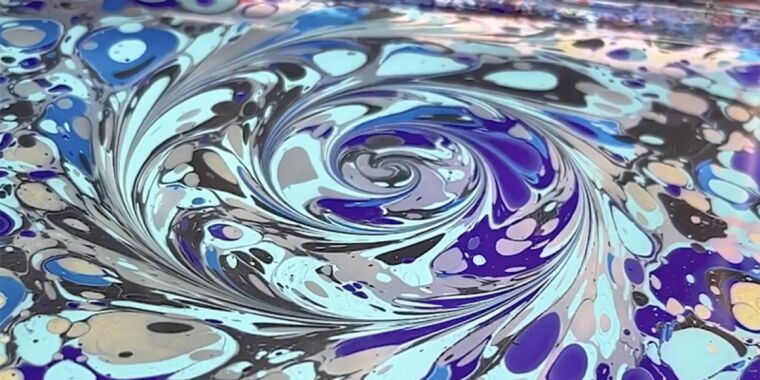Marbled paper, frosty fireworks among 2023 Gallery of Fluid Motion winners

Enlarge / Harvard University graduate student Yue Sun won a Milton Van Dyke Award for her video on the hydrodynamics of marbled paper.
Y. Sun/Harvard University et al.
Marbled paper is an art form that dates back at least to the 17th century, when European travelers to the Middle East brought back samples and bound them into albums. Its visually striking patterns arise from the complex hydrodynamics of paint interacting with water, inspiring a winning video entry in this year’s Gallery of Fluid Motion.
The American Physical Society’s Division of Fluid Dynamics sponsors the gallery each year as part of its annual meeting, featuring videos and posters submitted by scientists from all over the world. The objective is to highlight “the captivating science and often breathtaking beauty of fluid motion” and to “celebrate and appreciate the remarkable fluid dynamics phenomena unveiled by researchers and physicists.”
The three videos featured here are the winners of the Milton Van Dyke Awards, which also included three winning posters. There were three additional general video winners—on the atomization of impinging jets, the emergent collective motion of condensate droplets, and the swimming motion of a robotic eel—as well as three poster winners. You can view all the 2023 entries (winning and otherwise) here.
The hydrodynamics of marbling art
Harvard University graduate student Yue Sun was fascinated by the process and the resulting patterns of making marbled paper, particularly the randomness. “You don’t really know what you’re going to end up with until you have it printed,” she told Physics Magazine.
Although there are several different methods for marbling paper, the most common involves filling a shallow tray with water, then painstakingly applying different ink or paint colors to the water’s surface with an ink brush to cover the surface with concentric circles. Adding surfactants makes the colors float so that they can be stirred—perhaps with a very fine human hair—or fanned out by blowing on the circles of ink or paint with a straw. The final step is to lay paper on top to capture the colorful floating patterns. (Body marbling relies on a similar process, except the floating patterns are transferred onto a person’s skin.)
Sun was curious about the hydrodynamics at play and explored two key questions in the simulations for the video. Why does the paint or ink float despite being denser than the liquid bath? And why don’t the colors mix together to create new colors when agitated or stirred? The answer to the former is basically “surface tension,” while the latter does not occur because the bath is too viscous, so the diffusion of the paint or ink colors across color boundaries happens too slowly for mixing. Sun hopes to further improve her simulations of marbling in hopes of reverse-engineering some of her favorite patterns to determine which tools and movements were used to create them.
Marbled paper, frosty fireworks among 2023 Gallery of Fluid Motion winners Read More »
